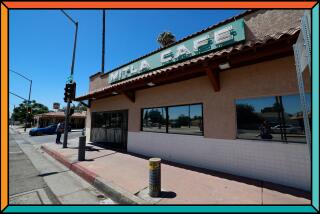A Little Bit of Mexico
- Share via
SANTA ANA — She had been in California only a few days, newly arrived from Mexico City, when Teresa Ruiz happened upon Calle Cuatro. Seeing the street was like watching all the nostalgia in her heart pour out and materialize into a vision of home.
“All of the sudden, I was back in Mexico,” said Ruiz, a former nurse who left her career in Mexico to become a nanny in the South County suburbs. “I started to cry. I couldn’t believe that here in Orange County there would be a place like this.”
That encounter was three years ago, and Ruiz, who lived in Laguna Hills until recently moving to Santa Ana, has been back to 4th Street nearly every weekend since.
“I come here to feel the warmth of Mexico,” she said, knitting a blue doily as she sat at one of a dozen concrete picnic tables on a pedestrian walkway next to the street. “I love California, but sometimes it feels good to go back to your roots.”
Once part of a thriving business district known for fine clothing, the street was virtually abandoned in the 1970s, its shoppers drawn away to new, more convenient malls. Cracking sidewalks ran past vacant storefronts, blood banks and seedy bars.
But in the last 10 years, thanks in part to a $12-million redevelopment project that stressed Latino heritage, a five-block stretch of 4th Street has been reborn into the closest thing Orange County has to a traditional Mexican plaza.
Anchored by new retail buildings painted in pastels and featuring a bricked-in pedestrian plaza with a carousel that runs on weekends only, the street is packed each Saturday and Sunday, primarily with a mix of recent immigrants and U.S.-born Latinos drawn to its comfortable, safe and familiar ambience.
“It’s just like in Mexico, where families spend the whole day at the Zocalo,” said Rueben Martinez, who owns Martinez books on Broadway and has worked in downtown Santa Ana for 23 years. “It’s a day for the family. You’ve got mothers and fathers holding on to their kids, just spending time together. This is their downtown area. The music is there, the food is there, the language is there.”
Saturday afternoon, coaxed outside by the warm sun, scores of families strolled, ice cream cups in hand, beneath flags of the United States, Mexico and California. They came for bargains in the shoe stores, clothing boutiques, furniture outlets and music shops that now line the street, many advertising in Spanish: Ropa fina! Oferta!
They set their children on the 50-cent carousel, or shared a pizza at a picnic table, tossing crumbs to the pigeons and watching the slow parade on the brick pedestrian plaza, once Spurgeon Street.
“Que van a llevar?” Ysena Flores called out from her sidewalk food cart, stocked with bags of cut papaya, jicama and watermelon, all sprinkled with chile; pork rinds shaped into wagon wheels; pumpkin seeds heavy with salt; and shaved ice. “What will you take?”
“I like these the best,” said Martha Cortez, balancing her year-old son and a cardboard platter of nances--tangy cherry-shaped fruit from Mexico. “You can’t find this stuff in Garden Grove, where I live,” said Cortez, 18, the daughter of immigrants from Chiapas state. “I don’t think there’s anything in the county like this.”
Nearby, Pablo Guzman and Maria Torres leaned against the wall of Mariscos Tampico, a seafood restaurant, watching their three young daughters ride the carousel. Guzman, who came north from Nayarit state 11 years ago and has worked ever since in a plastics factory, recalled how the downtown area had changed, how his first memories were of streets choked with drunks and panhandlers.
“Now we come, do some shopping, have something to eat, maybe see a movie” he said. “This is our weekend together.”
From Aliso Viejo, Laguna Niguel, Anaheim and Costa Mesa, families came for communal relaxation, a kind of togetherness that didn’t require anyone to speak, but just sit quietly.
“I like to just sit back and listen,” said Ruiz, “especially to the old men who sit under the palm trees. “
A short walk away, the old men faced each other on concrete benches under the trees. One in a straw cowboy hat, one leaning on a cane, one with a dapper leather vest.
“We practically live here,” said Margarito Robles, who came north from Fresnillo, Nayarit to work in the orange groves three decades ago. Like the others, he retired more than 10 years ago.
“We youngsters set up office here in the morning and tell lies all day,” he said.
They remembered decades past when the Yost Theater behind them, now home to a Pentecostal church, featured such distinguished Latino artists as Pedro Enfante and Dolores del Rio.
“We Hispanos have been here a long time,” said Fred Martinez, the son of Mexican immigrants, born in Azusa 70-odd years ago.
Down 4th Street, above the squeals of children and the calls of sidewalk vendors, rose the sound of a guitar. Tony Miranda, an accountant taking a break from the Casa Latina income tax agency, sat on a wrought iron fence and strummed.
The son of Mexican immigrants, who moonlights in a rock band, said most of his knowledge of Mexico comes from living and working in downtown Santa Ana. Miranda was born and raised there. “For the people who come here, it’s their home away from home,” he said. “As far as I can tell, it’s pretty much like Mexico.”
More to Read
Sign up for The Wild
We’ll help you find the best places to hike, bike and run, as well as the perfect silent spots for meditation and yoga.
You may occasionally receive promotional content from the Los Angeles Times.






